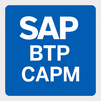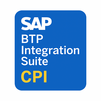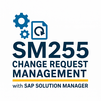.jpg)
SAP Document Compliance (SDC) Training provides in-depth learning on automating electronic document processing for global tax compliance. The course covers eDocument Framework, country-specific legal content, real-time e-invoice clearance, statutory reporting, integration with SAP S/4HANA, SAP BTP, and monitoring with AIF and Document Compliance Cockpit. Participants master handling e-invoices, credit notes, transport documents, and more, ensuring seamless, audit-ready compliance across jurisdictions. Ideal for SAP consultants, tax specialists, and compliance managers.
SAP Document Compliance (SDC) Training Interview Questions Answers - For Intermediate
1. What is the role of SAP Cloud Integration in the context of SAP Document Compliance?
SAP Cloud Integration (part of SAP Integration Suite) plays a critical role in enabling seamless communication between SAP systems and external government platforms. It handles message transformation, secure transmission, and connectivity for country-specific e-invoicing and statutory reporting. SAP provides pre-built integration content for many jurisdictions, which reduces implementation time and ensures compliance with local transmission standards. Cloud Integration also supports error handling and monitoring for e-document flows.
2. How does SAP Document Compliance support the validation of electronic documents?
SAP Document Compliance includes built-in validation mechanisms that ensure documents meet the syntactic and semantic requirements of local tax authorities. The validation checks are country-specific and cover areas such as mandatory fields, format compliance (such as XML schemas), tax calculations, and document consistency. Invalid documents are flagged, and error messages guide users to correct issues before transmission, reducing rejection rates by tax authorities.
3. What is the Document Compliance Cockpit and what are its key functions?
The Document Compliance Cockpit is a centralized monitoring and management interface within SAP Document Compliance. It allows users to track the lifecycle of electronic documents, from creation to submission and acknowledgment. Users can view document status, handle exceptions, perform reprocessing, and generate audit reports. The cockpit provides real-time visibility into compliance performance and helps streamline document management for finance and compliance teams.
4. How does SAP Document Compliance handle e-document sequencing and number ranges?
SAP Document Compliance supports the management of legal sequencing requirements for electronic documents. In many countries, tax authorities mandate that invoice numbers follow a strict sequence without gaps. SDC ensures that each document is assigned a legally compliant number range and maintains a complete audit trail. In case of errors or resubmissions, the system handles number reservation and cancellation procedures according to local regulations.
5. What are the options for archiving signed or approved electronic invoices in SDC?
SAP Document Compliance supports secure archiving of signed or approved electronic invoices through integration with SAP ArchiveLink and certified storage systems. Signed invoices, along with tax authority acknowledgments or approval receipts, are stored in compliance with country-specific legal retention periods. Archived documents remain accessible for audit purposes and can be retrieved via the Document Compliance Cockpit or reporting tools.
6. How does SAP Document Compliance manage updates to country-specific legal content?
SAP maintains a dedicated content lifecycle for country-specific legal updates. Updates are delivered via SAP Notes (for on-premise deployments) or automatically in the cloud edition through SAP Business Technology Platform (BTP). Updates may include new schemas, transmission protocols, reporting logic, and validation rules. Customers receive regular notifications of updates and can test changes in sandbox environments before deploying them to production.
7. What is the role of SAP Application Interface Framework (AIF) in SAP Document Compliance?
SAP Application Interface Framework (AIF) is used to monitor and manage the technical processing of messages in SAP Document Compliance. It provides tools to track message flows, identify and resolve errors, and visualize the end-to-end processing of electronic documents. AIF also supports retries and reprocessing in case of transmission failures, ensuring high data quality and reliability in e-document compliance.
8. How does SDC handle error messages and exceptions during document processing?
When an error occurs during document creation, validation, or submission, SAP Document Compliance captures detailed error messages. These are visible in both the Document Compliance Cockpit and AIF. The system provides drill-down navigation to the affected business document and highlights the cause of the issue (such as missing mandatory fields or incorrect tax values). Exception workflows guide users through resolution steps, improving process efficiency.
9. How does SAP Document Compliance manage different versions of tax authority APIs?
Tax authorities often update their APIs or e-document formats as regulations evolve. SAP Document Compliance manages multiple versions of these APIs through its version control framework. Customers can configure which version is active in their landscape. SAP delivers compatibility updates and deprecation notices as part of its legal content maintenance, ensuring that businesses can smoothly transition to new API versions.
10. What is the significance of the eDocument Framework in SAP Document Compliance?
The eDocument Framework is the core architecture behind SAP Document Compliance. It provides the engine for creating, mapping, and managing electronic documents based on source business transactions. The framework includes mapping tools, validation logic, versioning support, and integration with SAP Cloud Integration or AIF. It enables flexible adaptation to country-specific requirements and supports the reuse of core business data across multiple compliance processes.
11. What monitoring options are available for tracking document submission to tax authorities?
SAP Document Compliance provides several monitoring options. The Document Compliance Cockpit offers a user-friendly interface for business users, while SAP AIF provides deeper technical insights for IT teams. Both tools allow users to track submission status (such as "Submitted," "Accepted," "Rejected," "Pending"), view tax authority acknowledgments, and analyze processing times. Real-time dashboards and alerts can also be configured to highlight urgent compliance issues.
12. How does SDC handle the generation of multiple e-document formats for different countries?
SAP Document Compliance uses country-specific content packages to generate electronic documents in the required formats. These packages contain templates, mappings, and validation rules for formats such as UBL, Facturae, FatturaPA, CFDI, and others. The eDocument Framework allows dynamic determination of the correct format based on the document’s country and business context, enabling multi-country compliance in a single system.
13. What is the role of digital signatures in SAP Document Compliance?
In many jurisdictions, digital signatures are required to ensure the authenticity and integrity of electronic documents. SAP Document Compliance supports the integration of digital signature services, either using SAP’s own services on BTP or certified third-party providers. The system manages signature application during document processing and ensures that signed documents are stored securely for audit purposes. Signature validation is also supported for incoming documents.
14. How does SAP Document Compliance support data privacy and security requirements?
SAP Document Compliance is designed to meet stringent data privacy and security requirements. It supports encryption of transmitted data, secure storage of sensitive documents, and access control through SAP authorization mechanisms. In cloud deployments, SAP ensures data isolation and compliance with international security standards (such as ISO 27001 and GDPR). Audit trails are maintained for all document processing activities, supporting transparency and compliance.
15. What are key implementation considerations when deploying SAP Document Compliance?
Key implementation considerations for SAP Document Compliance include understanding country-specific legal requirements, selecting appropriate deployment options (on-premise or cloud), ensuring proper integration with existing SAP systems, and preparing for testing with tax authority platforms. Businesses should also establish monitoring processes, plan for ongoing content updates, and ensure alignment between IT, tax, and finance teams. A well-planned rollout helps mitigate risks and accelerates the time to compliance.
SAP Document Compliance (SDC) Training Interview Questions Answers - For Advanced
1. How does SAP Document Compliance support multi-instance SAP landscapes (SAP ECC + S/4HANA + legacy systems)?
SAP Document Compliance is designed to accommodate complex multi-instance SAP landscapes. In such environments, multiple SAP ERP (ECC or S/4HANA) instances may operate alongside legacy or third-party systems. The eDocument Framework can be deployed centrally, allowing documents to be generated from multiple systems and processed through a unified compliance pipeline. Using SAP Business Technology Platform (BTP), data can be harmonized and transmitted centrally to tax authorities. Pre-built connectors allow seamless integration between legacy systems and the SDC framework, ensuring consistent compliance across all parts of the organization without duplicating logic or effort in each instance.
2. How does SDC handle electronic credit notes and debit notes in jurisdictions with strict regulatory controls?
SAP Document Compliance provides full lifecycle support for credit notes and debit notes. In jurisdictions where such documents are subject to strict controls (e.g., they must reference the original invoice, have their own sequence, and must be cleared with tax authorities), SDC automates this process. The system enforces mandatory field population, document linkage to original invoices, and sequencing integrity. Credit and debit notes follow the same submission, validation, and acknowledgment workflow as invoices. SDC ensures auditability by maintaining a traceable relationship between original invoices and related adjustment documents in the document history.
3. What are the scalability considerations when implementing SDC for large volumes of documents?
When processing high volumes of documents, scalability is a key consideration. SAP Document Compliance is built to handle large transaction volumes, leveraging asynchronous processing, parallelization, and SAP HANA in-memory capabilities in S/4HANA environments. For cloud-based processing, SAP BTP provides elastic scalability and load balancing across integration flows. Organizations can also partition processing by legal entity or region to optimize throughput. Advanced monitoring tools help detect performance bottlenecks and allow tuning of batch sizes, processing intervals, and retry logic to achieve optimal performance even for organizations generating millions of documents monthly.
4. How does SDC support integration with SAP Global Trade Services (GTS)?
SAP Document Compliance integrates with SAP Global Trade Services (GTS) to support end-to-end compliance for cross-border transactions. For example, e-transport documents (such as export declarations) generated in GTS can be linked to corresponding invoices processed through SDC. This integration ensures consistency between trade compliance and tax reporting, reducing the risk of discrepancies. Furthermore, the combined use of GTS and SDC enables organizations to automate complex compliance scenarios, such as customs clearance linked to VAT e-invoicing, improving compliance efficiency for international supply chains.
5. How is audit readiness ensured with SAP Document Compliance?
Audit readiness is built into the architecture of SAP Document Compliance. Every document processed through SDC maintains a complete and immutable audit trail, tracking the full lifecycle of the document—from creation, through validation, submission, acknowledgment, correction (if applicable), to final archiving. All interactions with tax authorities are logged, including timestamps, message payloads, and response codes. The Document Compliance Cockpit and AIF provide auditable views of these processes. Additionally, integration with certified archiving solutions ensures that documents are retained according to country-specific legal periods and can be retrieved quickly during audits.
6. How does SDC manage varying VAT and GST requirements across different jurisdictions?
SDC handles varying VAT and GST requirements through country-specific content packages that implement local tax logic, validation rules, and reporting formats. The system dynamically determines applicable VAT/GST rules based on transaction data (e.g., customer location, material tax classification, tax jurisdiction codes). These rules influence tax calculations, document structure, and legal reporting obligations. SDC ensures that output documents comply with country-specific VAT/GST invoice content requirements, including breakdowns, exemptions, and zero-rated tax treatments. As VAT/GST laws evolve, SAP delivers regular updates to maintain compliance without requiring core system changes.
7. What mechanisms does SAP Document Compliance provide for handling corrections and cancellations of documents?
Correction and cancellation processes vary significantly by country, and SAP Document Compliance supports these variations through flexible process flows. For example, in some jurisdictions, a corrected invoice must reference the original document and follow a strict versioning model, while in others, a full cancellation followed by reissuance is required. SDC supports both models and enforces country-specific legal rules. The system provides dedicated correction and cancellation workflows, automates submission of required notifications to tax authorities, and maintains clear audit trails of all corrections and cancellations to ensure full legal traceability.
8. How does SDC handle duplicate invoice prevention and detection?
Duplicate invoice prevention is an important compliance and financial control. SAP Document Compliance includes built-in validation to detect potential duplicates based on document content, invoice number, date, and business partner references. If a duplicate is detected during validation or submission, the system can block processing, notify responsible users, and log the event for review. Additionally, integration with SAP Invoice Management and Accounts Payable workflows enhances duplicate detection by cross-referencing invoices in the broader financial system, preventing accidental duplicate tax reporting or payments.
9. How can organizations customize eDocument layouts or add customer-specific fields in SDC?
The eDocument Framework in SAP Document Compliance is highly extensible. Customers can use BAdIs (Business Add-Ins), enhancement spots, or the Document Compliance Customizing cockpit to add custom fields or modify document mappings. The framework allows customer-specific fields to be added to the XML payload or PDF versions of documents (if required). SAP also provides extensibility guides and documentation to ensure these customizations remain upgrade-safe. Through controlled customization, organizations can address specific business needs while maintaining alignment with legal content delivered by SAP.
10. How does SDC ensure legal compliance with invoice sequencing in jurisdictions with strict audit requirements?
Many tax authorities require strict sequencing of invoices with no gaps or duplicates. SAP Document Compliance manages legal sequencing through a robust number range management framework. The system can assign legal invoice numbers at the appropriate stage in the business process (posting or clearance, depending on jurisdiction). It reserves and tracks numbers, ensuring that gaps are handled according to legal rules (for example, cancellation of unused numbers). Full sequencing audit trails are maintained and can be reported for tax authority audits. SDC’s compliance with sequencing mandates helps organizations avoid significant audit penalties.
11. What role does SAP Cloud Identity Services play in securing SDC integrations?
SAP Cloud Identity Services play a crucial role in securing integrations between SAP Document Compliance and external tax platforms. They provide authentication, authorization, and identity federation, ensuring that only trusted systems and users can access sensitive e-document processing flows. In BTP-based deployments, Cloud Identity Services enforce secure API access to SAP Cloud Integration, signature services, and tax authority endpoints. This layer of security is critical in environments where e-invoicing involves financial and personal data, helping organizations meet GDPR and other data privacy regulations while maintaining compliance with national tax frameworks.
12. How does SAP Document Compliance support business partner-specific requirements (customer or supplier-specific e-invoice formats)?
In addition to supporting tax authority-mandated formats, SAP Document Compliance can accommodate customer or supplier-specific requirements through flexible mapping and transformation capabilities. Using user exits, BAdIs, or SAP Cloud Integration transformations, organizations can tailor document layouts, add partner-specific fields, or adjust delivery channels (e.g., via email, EDI, or customer portals). SDC also supports conditional logic to switch between standard legal formats and partner-specific formats based on business partner master data. This flexibility ensures that companies can meet both statutory and commercial obligations without maintaining parallel processes.
13. How can SDC integrate with SAP Ariba for seamless source-to-pay compliance?
SAP Document Compliance integrates with SAP Ariba to provide end-to-end source-to-pay compliance. For outbound transactions, invoices generated from SAP S/4HANA or ECC via SDC can be automatically synchronized with Ariba Network, ensuring that customers receive compliant invoices through their procurement channels. For inbound invoices, SDC can process e-invoices received via Ariba Network, validate them against tax authority rules, and feed them into SAP Accounts Payable processes. This integration supports compliant electronic invoicing across both procurement and financial domains, helping organizations achieve digital compliance across their entire supply chain.
14. How does SAP Document Compliance manage versioning and backward compatibility of legal content?
SAP manages versioning of legal content through structured content lifecycle processes. When tax authorities introduce new schemas or API versions, SAP delivers updated content with clear validity dates and coexistence guidance. The eDocument Framework can support multiple versions in parallel, allowing businesses to process both old and new formats during transition periods. Version control mechanisms in SDC ensure that each document is processed with the correct version of mappings, validation rules, and transmission protocols. This capability is essential for managing phased rollouts of new legal requirements while maintaining compliance with older obligations.
15. How does SAP Document Compliance contribute to operational efficiency and compliance cost reduction?
SAP Document Compliance streamlines compliance by automating manual document processing tasks, reducing the risk of human error, and eliminating paper-based processes. It enables real-time compliance, ensuring that invoices and reports are validated and accepted faster. Centralized monitoring tools reduce the time spent on exception handling and audits. Moreover, SAP’s continuous delivery of legal content updates minimizes internal IT effort to adapt to regulatory changes. As a result, companies experience significant reductions in compliance costs, improved accuracy in tax reporting, and faster cash flow cycles due to timely and compliant invoicing processes.
Course Schedule
| Dec, 2025 | Weekdays | Mon-Fri | Enquire Now |
| Weekend | Sat-Sun | Enquire Now | |
| Jan, 2026 | Weekdays | Mon-Fri | Enquire Now |
| Weekend | Sat-Sun | Enquire Now |
Related Courses
Related Articles
Related Interview
Related FAQ's
- Instructor-led Live Online Interactive Training
- Project Based Customized Learning
- Fast Track Training Program
- Self-paced learning
- In one-on-one training, you have the flexibility to choose the days, timings, and duration according to your preferences.
- We create a personalized training calendar based on your chosen schedule.
- Complete Live Online Interactive Training of the Course
- After Training Recorded Videos
- Session-wise Learning Material and notes for lifetime
- Practical & Assignments exercises
- Global Course Completion Certificate
- 24x7 after Training Support











 Join our Live Instructor-Led online classes delivered by industry experts
Join our Live Instructor-Led online classes delivered by industry experts